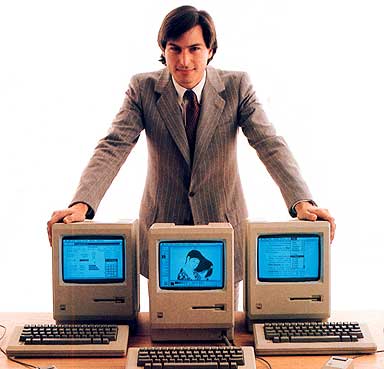“The use of computers in science now may bring images of data-crunching parallel processing and Unix-inspired open-source collaborations, but there was a time when the cutting edge — at least for molecular scientists — was being able to draw a benzene ring digitally on screen. Jobs and Apple gave scientists the power to do that, and more besides. Scientists responded with decades of loyalty and, on news of Jobs’s death, with tributes of their own.”
 In some fields, such as design and publishing, Macs reign supreme. Science, especially biology, is another area where Macs have been prevalent.
In some fields, such as design and publishing, Macs reign supreme. Science, especially biology, is another area where Macs have been prevalent.
I used my first Mac in college in 1984. It was the original, quickly replaced with a Fat Mac soon after (Boston College was a key Apple school). Soon after graduating, I bought my first Mac, a Mac II. I would use that Mac for almost 10 years to write my PhD thesis, organize my wedding, create some animations (2D and 3D), and write a book and countless short stories.
In the lab
In grad school (’89-’94), we had a zippy Mac SE and another small 9″ Mac (I don’t recall which) in our lab. My boss wrote software to render and animate DNA, for non-linear regression, and run the instruments in the lab (HPLC, pumps, and specs). We also used the computers to design and plan experiments, draw molecules, and keep our lab reagents catalogs (on HyperCard, of course).
In my post-doc lab (’94-99), we had fast, colour machines for writing papers, making slides, keep our reagents catalogs, email (big thing then), surf the new and burgeoning Web (on Mosaic and Netscape 1) for genomic info, ordering, DNA alignments, running instruments, and non-linear regression. The interesting thing is by my post-doc, there were software packages that could do all the things my grad-school advisor has programmed. Quite a change for someone like me who doesn’t program.
No more lab
I left the lab and eventually found my way to a PC-centric corporation – Nokia. I had a few Macs at home, but craved to use it once more at work. After about 5 years, I did get one, and, of course, it transformed how I worked. [Indeed, I used to point out that Nokia kept getting blind-sided by Apple because Nokia’s PCs acted as blinders as to what personal electronics could be like.]
When I left Nokia, I entered a media producer role with two zippy cutting-edge, totally loaded Macs with great software and screen real-estate.
But now, in my current job, I am back to PC-ville, though not so hobbled as in the old days – Windows 7 isn’t so bad (though nothing really works as polished as it does on a Mac – loads of examples), and I still use Firefox and Seesmic as I did on the Mac.
Of course, we still have a few Macs at home and I hope to return to using a Mac for business in the near future.
Lab Macs rule
In any case, I’ve used Macs in all sorts of settings and have suffered the PC world. And Mr Jobs has indeed transformed my life, as he did the lives of all the scientists I worked with. This retrospective of mine was triggered by the article quoted above (link below). It’s a nice commentary of how, even though Apple was trying to be the business computer of choice, it ended up being a strong force in science.
What do you think? How Mac-centric is your lab? Could you imagine doing science without Macs?
Image from MacRumors
To be honest, I was more of a Wozniak fan in the early days, due to his hacker / prankster style. I learned to program on the Apple II+, a skill that has served me well as a scientist and an engineer. I gave up on Apple’s products when the Macintosh superseded the Apple II line, which I thought at the time had a lot more potential than the Mac. I may have been wrong there.
However, when Steve Jobs returned to Apple and brought the Unix core of the NeXT OS into Mac OS X, I started paying attention again. Several years ago, we decided we needed to focus on a single platform for development of our robotic control software and did an honest evaluation of Windows, Mac, and Linux. I was genuinely surprised to find how much more efficient Cocoa let you be as a developer, and how welcoming the community there was, so we switched all of our control computers to Macs and haven’t looked back. We now ship an iMac with each of our systems, which print microscale volumes of fluid for fabricating microcircuitry, biomolecules for microarrays, or even live cells for artificial tissue patterning.
On the side, I’ve spun the same Mac development skills I acquired into some hobby iOS development I do on the side. I wrote an open source molecular modeler for the iPhone and iPad called Molecules, which has been downloaded nearly 1.8 million times to date. The stories I hear about Apple’s mobile devices being used in the lab and the classroom have impressed upon me the huge impact that Apple’s current products are having in education and the sciences.
Moving our development to the Mac (and iOS) has been one of the best decisions I’ve made in the last several years, and it continues to pay dividends.
Wow! Thanks for sharing! And may your success on the Mac continue.